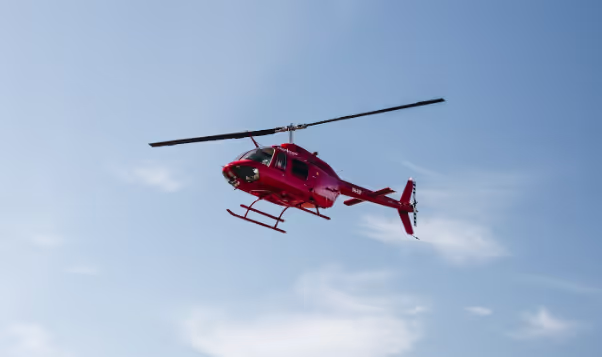Stay informed with our newsletter.
.webp)

.webp)

United Therapeutics has achieved a significant milestone by completing the inaugural flight of its hydrogen-powered helicopter. This groundbreaking achievement showcases the potential of clean energy in aviation and highlights the company’s commitment to sustainable transportation solutions. The flight demonstrates the feasibility of hydrogen fuel as an alternative to traditional aviation fuels, offering lower emissions and a greener future for air travel. This innovation could help revolutionize how helicopters and other aircraft are powered in the years ahead.

Unither Bioelectronics, a division of United Therapeutics, has achieved a major breakthrough by completing the world’s first crewed flight using hydrogen-electric technology in a helicopter.
On March 27, 2025, an experimental model of the Robinson R44 helicopter lifted off from Roland-Désourdy Airport in Bromont, Quebec, Canada. This event represents a key advancement in the movement toward air travel without emissions.
Though the duration of the flight was just over three minutes, it played a vital role in demonstrating that a hydrogen fuel cell system can effectively power a helicopter. The test showcased the aircraft’s ability to hover and perform basic maneuvers, underscoring the practical potential of hydrogen-electric propulsion in vertical takeoff and landing scenarios.
This innovation forms part of Project Proticity, a joint initiative between Unither Bioelectronics and Robinson Helicopter Company that began in August 2024. The project's main goal is to create hydrogen-powered versions of Robinson’s existing helicopter models, beginning with the retrofitting of the R44.
For Unither, which also operates in the field of medical transport, this development has meaningful implications. A hydrogen-electric aircraft could revolutionize the way organs are transported for transplants, enabling faster, more sustainable delivery solutions.
Mikael Cardinal, Vice President at Unither Bioelectronics responsible for organ delivery systems, emphasized the success of the test in proving their hydrogen propulsion system’s ability to hover and maneuver. He added that the next step in development will involve integrating liquid hydrogen storage. This component is expected to support extended-range missions, essential for delivering lab-grown organ alternatives to patients across longer distances.
Technically, the R44 helicopter used in the flight was transformed by removing its traditional piston engine and replacing it with a hydrogen-based powertrain. This system consisted of two proton exchange membrane (PEM) fuel cells, a Magnix electric motor, and a compact battery to manage varying power demands during the flight.
Remarkably, hydrogen supplied about 90% of the energy used in the test, highlighting the efficiency and practicality of the setup.
Unither noted that this historic flight represents a foundational achievement toward establishing certification standards and design practices for future hydrogen-powered aircraft. It also marked several aviation milestones: the first time a hydrogen-powered helicopter has flown with a pilot, the first manned hydrogen flight in Canada, and a successful demonstration of hydrogen fuel cells for VTOL applications.
David Smith, CEO of Robinson Helicopter, called the achievement a landmark moment in aviation. He highlighted the flight as a pivotal first step in the journey toward emission-free, long-distance vertical flight.
Hydrogen-fueled helicopters matter significantly because they generate only water vapor as a byproduct. This positions them as a clean and sustainable alternative to conventional aviation fuel, which contributes heavily to carbon emissions.
The impact of this development goes well beyond helicopter design. It signals a meaningful advance for several key areas: the move toward zero-emission aircraft, improvements in medical logistics through low-emission, long-distance transport, and overall progress in hydrogen propulsion—especially as larger aerospace players face delays in hydrogen-based aircraft.
However, despite this notable progress, there are still challenges to overcome. Hydrogen aviation is still in its infancy, and the infrastructure for producing, storing, and distributing hydrogen remains underdeveloped. Regulatory bodies must also adapt to keep up with rapid technological advancements in this area.
Still, the potential benefits of hydrogen aviation are significant. By reducing greenhouse gas emissions, hydrogen technology can help make aviation more climate-friendly. The introduction of liquid hydrogen storage systems, expected in future development stages, is likely to increase the range of these aircraft. This would make hydrogen-powered VTOLs suitable for a broader range of missions, including those in both remote and urban settings.
Considering aviation currently contributes around 2.5% of global carbon dioxide emissions, the hydrogen-powered helicopter developed by Unither Bioelectronics points to a cleaner path forward.
As the industry advances toward larger electric VTOL platforms and improves liquid hydrogen technologies, this successful flight represents more than just a technological feat, it serves as an inspiration for future innovation and a call for action across the aviation sector.
In the coming years, the familiar sound of combustion engines in the skies could be replaced by the quieter hum of clean, hydrogen-powered flight, bringing sustainable air travel closer to reality.
For questions or comments write to contactus@bostonbrandmedia.com
Source: sustainabilitymag
